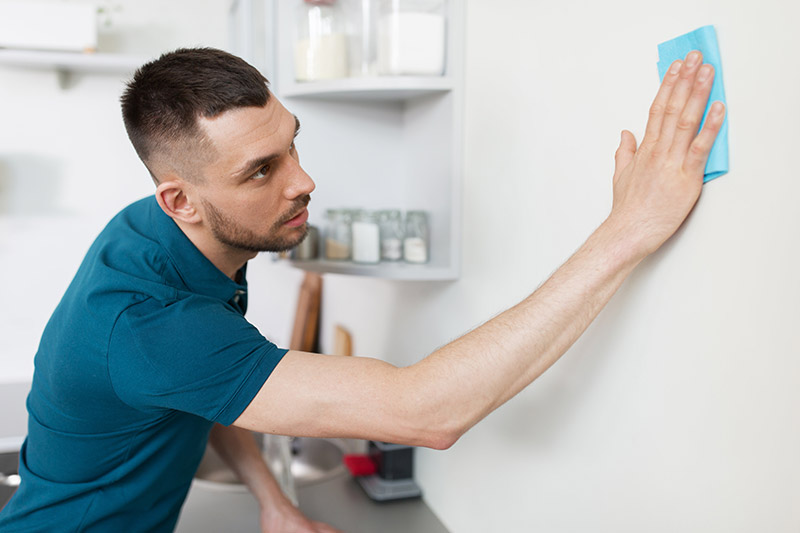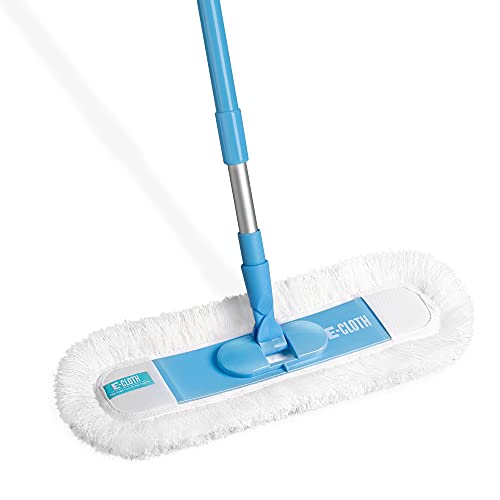How to Clean Walls Without Harsh Chemicals
This page may contain affiliate links. If you make a purchase through one of our affiliate links, we’ll earn a commission, at no extra cost to you. For more details, please read our disclosure.

For lots of people, keeping a clean and tidy home is a top priority. You might find great enjoyment in regularly cleaning your space and looking after your home. Or cleaning may be purely a necessity; something that needs to be done, ideally efficiently and without too much hard work.
Whichever category you fall into, we can all agree that keeping a clean home is important not only for our own wellbeing and peace of mind but also for our health and the health of anyone else within our households. But how often do you think about how to clean walls and actually do it?
When you think of cleaning your home, you probably think of vacuuming, mopping, wiping down kitchen surfaces, as well as other things. But how often do you clean the walls within your home? These are some of the largest surfaces in the home, making up the infrastructure of the building and acting as a canvas on which you can decorate and customize your living space, and yet, they are often neglected when it comes to our regular cleaning routines.
Cleaning your walls regularly might seem like a laborious, pointless job, but it can make a real difference to the overall look and feel of your home, and with regular maintenance, it doesn’t have to be a huge, time-consuming task.
Here, we are going to talk you through some of the best ways of cleaning your walls thoroughly and efficiently. Follow this step-by-step guide to achieve sparkling clean walls throughout your home.
Related: How to Clean Wood Doors
How to Clean Walls Without Harsh Chemicals
Dusting Your Walls
The first task at hand should be to remove any surface-level dust or dirt particles from the wall. Just as dust accumulates on tables and other hard surfaces, it can quickly build up on our walls.
Use a duster to sweep across all of your walls before beginning your deep clean. This duster from E-Cloth is a great option when it comes to cleaning walls or other hard-to-reach places.
 E-Cloth Flexi-Edge Floor & Wall Duster
E-Cloth Flexi-Edge Floor & Wall Duster
The Flexi-Edge Floor and Wall Duster has an aluminum handle that extends up to five feet for easy reach of high spots or awkward corners and crevices. The microfiber head is super flexible and grabs and traps dirt and dust particles effectively. The heads can be removed between uses and thrown in the laundry, lasting up to 200 washes.
Be sure to cover the entire wall and pay extra attention to any cornice or moldings where dust is most likely to linger.
Related: Clean a Messy House Checklist
How to Clean Walls
Now that any dust or loose dirt particles have been removed, you can move on to deep cleaning your walls. The method you use here will depend on the type of walls you are working with and the finish that has been used on them.
In terms of equipment, you will need to gather a few basic supplies before getting started. Firstly you will need distilled water. Distilled water won’t leave watermarks, so is always the best option when it comes to cleaning. You’ll also need a good-quality microfiber cloth. We highly recommend these ones, also from E-Cloth.
 E-Cloth General Purpose Cleaning Cloth
E-Cloth General Purpose Cleaning Cloth
They’re super effective, pick up dirt and dust particles easily and kill 99% of bacteria. They’re machine washable and also extremely durable, lasting up to three hundred washes.
You will also need a gentle cleaning solution. You could use your own preferred choice of detergent or surface cleaner, just make sure it is chemical-free to avoid any damage to the wall and also to prevent any potentially harmful toxins from being brought into your home. Alternatively, you could make your own by mixing equal parts distilled water and white vinegar in a clean spray bottle.
Depending on the type of wall you are working with, you might also need a dry brush, opt for one with natural fiber bristles that are not too stiff or abrasive.
 Dr. Bronner’s – Pure-Castile Liquid Soap
Dr. Bronner’s – Pure-Castile Liquid Soap
Related: How to Clean Baseboards
Walls with Water-Based Paint
Typically, water-based paints tend to be less durable than oil-based paints, and are more susceptible to staining. Spills or marks can quickly seep into the paintwork and will become increasingly difficult to remove the longer they are left to sit.
To clean these surfaces, you’re going to need to spray the wall with your choice of cleaning solution or use a natural cleaning wipe. White vinegar works great for removing stains and cutting through grease, grime, and bacteria, while still being gentle enough not to damage the surface of the paint.
Allow the solution to soak into the wall for a few minutes and then go in with your microfiber cloth, gently rubbing the entire wall. You should find that any marks lift right out of the paint without too much hard work.
Walls with Oil-Based Paint
Oil-based painted walls, on the other hand, tend to have a more durable finish, meaning that stains and marks can be wiped away more easily. However, oil-based paint is also generally more shiny or glossy than water-based paints. This means that even the gentlest of cleaning agents can cause damage to the paintwork.
For this reason, it is best to use distilled water only when cleaning oil-based painted walls. Spritz some distilled water over the wall’s surface and then clean the wall with an antibacterial microfiber cloth. This should be enough to remove any stains or marks without damaging the paintwork.
Walls with Wallpaper
Working with wallpapered walls can be a little more complex. Wallpaper tends to show watermarks much more than paint does, and some cleaning solutions might cause discoloration or surface damage to the wallpaper.
If possible, check any care labels or manufacturer labels that came with the wallpaper. In most cases, your white vinegar solution and microfiber cloth combination should be gentle enough to use here, but if you’re unsure, stick with distilled water and the same gentle, antibacterial microfiber cloth.
Interior Stone or Masonry Walls
Now, how to clean walls that are interior stone or masonry that tends to cling even more stubbornly to dirt and dust, so regular cleaning is super important. With these walls, you can usually afford to be a little tougher with your cleaning methods.
Spray over your choice of natural cleaning solution and then go in with your dry brush to loosen any dirt or debris and gently scrub the stonework to leave it clean and sanitized.
You can then finish off by spritzing over some distilled water and wiping it down with your microfiber cloth to remove any lingering dust particles.
Tackling Stubborn Stains
If, after carrying out your deep clean of the walls, you find that there are still some stubborn stains showing, there are a few further steps you could take to tackle these.
Baking soda is super effective when it comes to removing stains. It’s a natural deodorizer and has antibacterial properties. It’s also great for restoring brightness to surfaces and soft furnishings.
To use baking soda to remove stains from your walls, simply mix two parts of baking soda with 1 part of water and combine them to form a paste-like consistency. Work this into the stain and then leave it to soak for up to 10 minutes. Go back in with your microfiber cloth to remove the baking soda and the stain should lift right out.
Hydrogen peroxide works in a similar way and can also be applied to the wall and left to sit before being wiped away to lift out any stains or stubborn marks.
Both of these methods are highly effective but are not suitable for use on all wall surfaces. Always carry out a patch test and bear in mind that hydrogen peroxide, while completely natural, is a chemical compound and could cause color lifting or other damage to painted or wallpapered walls.
Drying the Walls
After going through the cleaning steps on How to Clean Walls, the final step is to ensure they are able to dry out fully as soon as possible.
While washing your walls, be careful not to over saturate them. Not only could this lead to lifting or bubbling of any paint or wallpaper, but it could also cause the growth of mildew or mold if the wall is unable to adequately dry out. This can be detrimental to your health and could cause permanent damage to your home.
Use minimal liquids when cleaning the walls and always allow plenty of ventilation afterward to help the walls dry out quickly.
You could also use a heater, air conditioner, or dehumidifier to speed this process along.
Related: Mold Behind Wallpaper? How to Remove It and Prevent It From Coming Back
Final Thoughts on How to Clean Walls Without Harsh Chemicals
Washing the walls within your home might not necessarily always be your number one priority, but it is a task that can make a huge difference to the overall cleanliness of your home. Your walls make up the basic infrastructure of your home, so it is super important that you keep them looking their best!
By carrying out an initial deep clean and then incorporating some of these techniques of how to clean walls into your regular cleaning routine, you should be able to maintain clean and fresh walls consistently, without too much hard work.
Always aim to clean up any spills or marks as soon as possible to prevent permanent staining, and regularly dust and wipe your walls with gentle, toxin-free cleaning products to keep them looking as clean as possible all of the time.
